Tlr4
-
Official Full Name
toll-like receptor 4
-
Overview
Cooperates with LY96 and CD14 to mediate the innate immune response to bacterial lipopolysaccharide (LPS). Acts via MYD88, TIRAP and TRAF6, leading to NF-kappa-B activation, cytokine secretion and the inflammatory response. Also involved in LPS-independent inflammatory responses triggered by Ni(2+). These responses require non-conserved histidines and are, therefore, species-specific. -
Synonyms
TLR4; toll-like receptor 4; Lps; Ly87; Ran/M1; Rasl2-8; lipopolysaccharide response;
- Recombinant Proteins
- Cell & Tissue Lysates
- Protein Pre-coupled Magnetic Beads
- Chicken
- Goat
- Human
- Mouse
- Rat
- Rhesus Macaque
- Rhesus monkey
- Baculovirus-Insect cells
- CHO
- E.coli
- HEK293
- HEK293T
- Human Cell
- Human Cells
- In Vitro Cell Free System
- Insect Cell
- Insect Cells
- Mammalian Cell
- Mammalian cells
- Wheat Germ
- Yeast
- C
- Fc
- His
- Strep
- DYKDDDDK
- Flag
- GST
- hIgG1
- hIgG4
- His (Fc)
- Avi
- His|S
- His|T7
- SUMO
- Myc
- DDK
- Myc|DDK
- N/A
- N
- Ser|His
- Background
- Quality Guarantee
- Case Study
- Involved Pathway
- Protein Function
- Interacting Protein
- Other Resource
What is TLR4 Protein?
The Toll-Like Receptor 4 (TLR4) protein is part of the Toll-like receptor (TLRs) family, discovered in Drosophila melanogaster during the 1980s and 1990s, while examining the fruit fly's embryonic development and immune responses. So, while TLRs were first detected in invertebrates, the discovery of their presence and functions in mammals, including humans, has brought forth a plethora of information on the molecular aspects of immunity. The TLRs are termed 'Toll-like' because of their structural and functional resemblance to the 'Toll' protein in Drosophila.
The TLR4 gene in humans is located on chromosome 9 and occupies the locus '9q33.1.' This gene has a unique structure comprising three exons, which encode a protein of 839 amino acids. TLR4's protein structure is characterized by extracellular leucine-rich repeats (LRRs) and a cytoplasmic Toll/interleukin-1 receptor (TIR) domain, which is the key signaling domain.
Function of TLR4 Protein
One primary role of TLR4 involves the identification of pathogen-associated molecular patterns (PAMPs). This system allows innate immune cells to detect pathogenic microorganisms, initiating a rapid defense response even before adaptive immunity develops. Specifically, TLR4 recognizes lipopolysaccharides (LPS) on Gram-negative bacteria, leading to the activation of the immune response. Furthermore, TLR4 is involved in the detection of viral proteins, fungal products, and certain endogenous ligands produced during tissue damage.
TLR4 Protein and Related Signal Pathways
TLR4 activates two distinct signaling pathways – MyD88-dependent and TRIF-dependent (also called MyD88-independent). MyD88-dependent pathway leads to the production of pro-inflammatory cytokines, while the TRIF-dependent pathway induces interferon-regulatory factors, triggering the synthesis of type I interferons (IFNs).
In the MyD88-dependant pathway, TLR4's activated state induces recruitment of the adaptor protein MyD88, triggering a cascade of events involving the activation of transcription factor NF-kB. This results in the production of pro-inflammatory cytokines that mediate the inflammation process.
On the other hand, the TRIF-dependent pathway is activated when TLR4, with the help of TRAM adaptor protein, recruits TRIF. This leads to the activation of transcription factors IRF3 and NF-kB, promoting the production of type I IFNs and inflammatory cytokines, respectively.
TLR4 Protein Related Diseases
While TLR4 plays a critical role in the immune response, its activation must be finely controlled. Its hyper-activation has been associated with various disease conditions. For instance, chronic inflammatory diseases such as atherosclerosis, chronic kidney disease, chronic obstructive pulmonary disease, and rheumatoid arthritis are often linked with TLR4 over-activation.
Similarly, aberrant TLR4 signaling is implicated in sepsis and various neurodegenerative diseases, including Alzheimer's disease and Parkinson's disease. Furthermore, certain cancer cells are known to express higher levels of TLR4, suggesting a link between TLR4 and tumorigenesis.
TLR4 Protein's Applications
Given its pivotal role in immunity, TLR4 protein has the potential for clinical applications. Certain TLR4 agonists, such as Monophosphoryl lipid A (MPLA), are used as vaccine adjuvants to boost immune responses. On the flip side, TLR4 antagonists are being investigated for their potential to inhibit inappropriate or over-exuberant inflammatory responses.
Moreover, the TLR4-LPS interaction is a popular model for studying innate immunity and inflammation. Thus, in addition to potential therapeutic applications, TLR4 continues to serve as a major tool for understanding the complex processes of the human immune system.
In conclusion, TLR4 protein has proven to be an important part of our immune response mechanism. The discoveries surrounding it have given us much insight into how our bodies tackle harmful pathogens. Continued research on TLR4 and other proteins like it promises to better our understanding of human health and disease and hopefully lead to more effective treatments. It is a fascinating testament to the intricacy of life at the cellular level, a topic that is as intriguing as it is complex.
High Purity

Fig1. 15% SDS-PAGE (Cat.No.: TLR4-7618H) Recombinant Human TLR4 protein, His & T7-tagged (Cys29~Leu253)
.
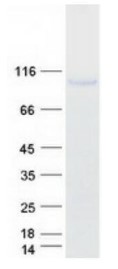
Fig2. SDS-PAGE (Cat. No.: TLR4-614HFL, Recombinant Full Length Human TLR4 Protein, C-Flag-tagged)
Bioactive
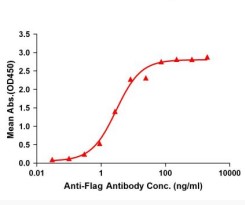
Fig3. TLR4-40689H, Active Recombinant Human TLR4 Full Length Transmembrane protein(Nanodisc)
.
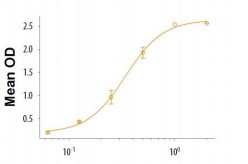
Fig4. When Recombinant Mouse TLR4 Fc Chimera is coated at 2 μg/mL (100 μL/well),
Case 1: Coveney AP, et al. Sci Rep. 2015.
Myeloid-related protein 8 (Mrp8) is the active component of Mrp8/14 protein complex released by phagocytes at the site of infection and stimulates inflammatory responses. However, it is unclear whether Mrp8 could induce self-tolerance and cross-tolerance to bacterial infection. Here the article reported that Mrp8 triggered TNF-α and IL-6 release via a Toll-like receptor 4 (TLR4)-dependent manner. TLR4, TLR2 also contributed to Mrp8-induced inflammatory response and tolerance.
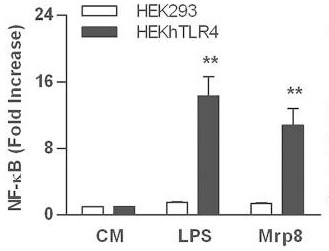
Fig1. TLR4 is involved in Mrp8-mediated inflammatory response and tolerance. HEK293 and HEKhTLR4 cells transfected with the NF-κB promoter luciferase plasmid were stimulated with CM, 5 μg/ml hMrp8, 100 ng/ml LPS or 100 ng/ml BLP for 6 h.
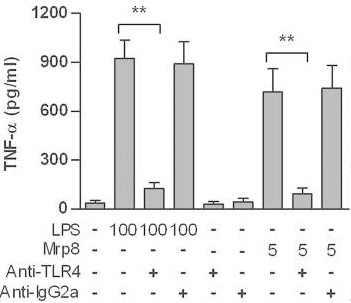
Fig2. Human monocytes were pre-incubated with 2 μg/ml of either the anti-TLR4 mAb (HTA125), or an isotype control mAb (IgG2a) for 30 min and further stimulated with 5 μg/ml hMrp8, 100 ng/ml LPS or 100 ng/ml BLP for 6 h.
Case 2: Luo S, et al. Cell Rep. 2023.
N6-methyladenosine (m6A) modification accounts for the most prevalent mRNA internal modification and has emerged as a widespread regulatory mechanism in multiple physiological processes. The article shows that the mRNA of TLR4 is modified by m6A, exhibiting increased translation and slowed degradation simultaneously, leading to elevated protein levels of TLR4, which eventually promotes the TLR4 signaling activation of neutrophil.
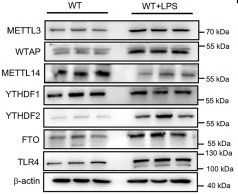
Fig1. Immunoblot analysis of METTL3 and other m6A-related protein expressions in bone marrow (BM) neutrophils with or without LPS intraperitoneal injection treatment.
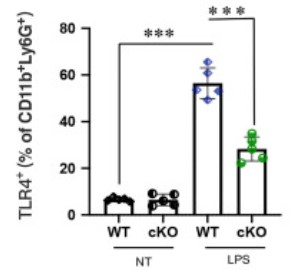
Fig2. TLR4 membrane expression in BM neutrophils in METTL3 cKO mice and METTL3 WT mice with or without LPS treatment (F, n = 5 mice per group).
Case 3: Ferreira-Gomes J, et al. J Pain Res. 2021.
Toll-like receptor 4 (TLR4) is a pattern recognition receptor involved in the detection of pathogen-associated molecular patterns (PAMPs), but also a "danger-sensing" receptor that recognizes host-derived endogenous molecules called damage-associated molecular patterns (DAMPs). In this study, they evaluated whether a systemic administration of a synthetic antagonist of TLR4 (TLR4-A1) could decrease nociception and cartilage degradation in experimental osteoarthritis (OA). Furthermore, as the activation transcription factor (ATF)-3 serves as a negative regulator for TLR4-stimulated inflammatory response, we also evaluated the effect of TLR4 inhibition on ATF-3 expression in primary afferent neurons at the dorsal root ganglia (DRG).
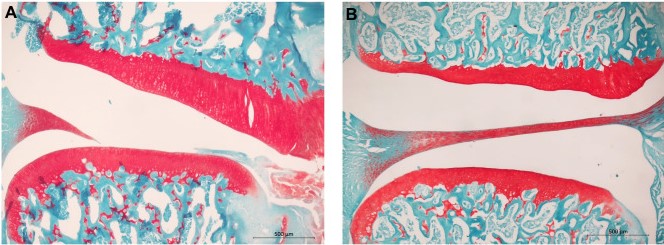
Fig1. Histopathology of knee joint sections stained with Safranin-O and Fast Green. Control-Vehicle (A) and Control-TLR4A1 (B) animals show unaltered articular cartilage (in red) and subchondral bone.
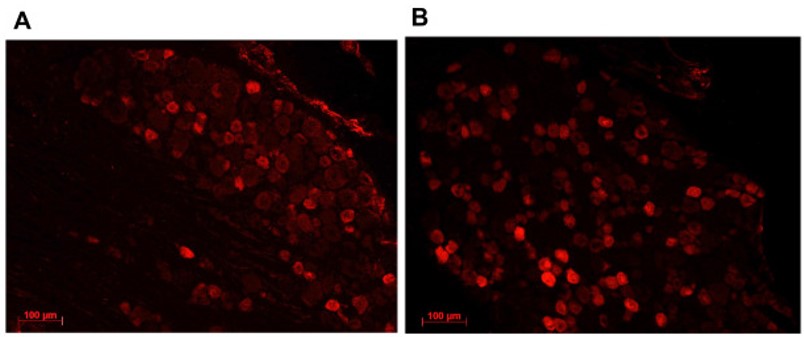
Fig2. TLR4 expression in DRG neurons. A, (B) Representative images of immunofluorescence labelling for TLR4 in ipsilateral DRGs of OA-Vehicle (A) and OA-TLR4A1 (B) animals.
Tlr4 involved in several pathways and played different roles in them. We selected most pathways Tlr4 participated on our site, such as NF-kappa B signaling pathway, HIF- signaling pathway, Phagosome, which may be useful for your reference. Also, other proteins which involved in the same pathway with Tlr4 were listed below. Creative BioMart supplied nearly all the proteins listed, you can search them on our site.
| Pathway Name | Pathway Related Protein |
|---|---|
| NF-kappa B signaling pathway | UBE2I;CD40;IL-8;CXCL12;GM1987;BCL2A1A;TNFRSF13C;TNFSF14;BIRC2 |
| HIF- signaling pathway | Trf;PRKCB;MAPK1;PIK3CA;MKNK2;ARNT;PDK1;HK2;RPS6KB2 |
| Phagosome | HLA-C;ITGB2L;BF1;HLA-F;ATP6V0A4;TUBAL3;NCF1;RAB5C;MHC1UEA |
| PIK-Akt signaling pathway | PTEN;PRKAA1;ITGAV;IRS1;EPO;PDGFRB;PPP2R2A;AKT1;IFNA10 |
| Toll-like receptor signaling pathway | IFNA2;TLR4;MAP2K1;NFKBIAA;AKT1;MAPK13;IRAK4;PIK3R5;MAP2K4B |
| Pathogenic Escherichia coli infection | CDC42;TLR5;TUBA1B;ABL1;TUBB2A;CTTN;PRKCA;YWHAZ;ROCK2 |
| Salmonella infection | TJP1;ACTB;NOS2;ARPC4L;NFKB1;RAB7A;ROCK1;ACTG1;IL1B |
| Pertussis | AMCF-II;C5;Il23a; Il12b;CXCL6;GNAI1;FOS;IRF8;MYD88;NOS2 |
| Legionellosis | TNF;ITGB2;ITGB2L;BNIP3;HSPA6;SEC22B;IL-8;EEF1G;HBS1L |
| Leishmaniasis | FCGR1A;FCGR1;ITGA4;H2-AA;IL4;HLA-DPB1;MAPK13;IFNG;IRAK1 |
| Chagas disease (American trypanosomiasis) | TGFB1;GNAQ;CD247;PIK3CG;BDKRB2;TGFB2;GNA14;FASLG;C3 |
| Malaria | VCAM1;Ccl12;HBB-B2;KLRB1;SDC2;KLRC4-KLRK1;SELE;DARC;TGFB1 |
| Toxoplasmosis | LAMB3;GNAI3;H2-AA;LAMA2;IRAK1;IL12B;HLA-DPB1;XIAP;AKT2 |
| Amoebiasis | NFKB1;LAMA4;TGFB3;COL4A3;GNAS;ACTN4;PIK3CG;SERPINB3;GNAQ |
| Tuberculosis | SPHK1;CD74;CAMK2G;Ifna15;AKT2;H2-AA;IFNA10;LAMP1;FCGR1A |
| Hepatitis B | IFIH1;IFNA8;EP300;MAPK9;TIRAP;SMAD3;PIK3CD;MAPK1;PTK2B |
| Measles | MAVS;IL2RB;NFKBIA;BBC3;IRAK1;IFNA7;CCND3;PIK3CD;AKT1 |
| Influenza A | Ifna11;BCL2L2-PABPN1;IL12A;HSPA8;IL1A;IKBKB;HLA-DRB5;MAP2K6;MAPK9 |
| Proteoglycans in cancer | PRKCG;Fasl;ITPR3;MAPK3;ITGB5;TWIST2;Ctsl;MSN;NANOG |
| Inflammatory bowel disease (IBD) | SMAD3;HLA-DRB4;IL18R1;NFATC1;IFNG;Il23a; Il12b;NFKB1;HLA-DPA1;IL13 |
| Rheumatoid arthritis | ATP6V1C1;IL23;ATP6V1H;FLT1;ATP6V0A1;TNF;CXCL5;ATP6V0D2;ATP6V1D |
Tlr4 has several biochemical functions, for example, lipopolysaccharide binding, lipopolysaccharide receptor activity, protein binding. Some of the functions are cooperated with other proteins, some of the functions could acted by Tlr4 itself. We selected most functions Tlr4 had, and list some proteins which have the same functions with Tlr4. You can find most of the proteins on our site.
| Function | Related Protein |
|---|---|
| lipopolysaccharide binding | RNASE7;TLR2;SPON2;BPI;TLR4;SELP;KIAA0644;BPIFC;SCARB1 |
| lipopolysaccharide receptor activity | TLR2;PTAFR;TLR4;SCARB1;LY96 |
| protein binding | SNRPA1;NRG4;CASP6;DLL1;KCNJ9;PCGF5;RNF19B;EPB41L1;PARD6B |
| receptor activity | NOTCH2;LILRB3;GABRA5;XPR1;DERL1;CNTNAP1;FKBP3;NLGN4X;RTN4RL2 |
| transmembrane signaling receptor activity | OR4N4;FCAMR;FZD3A;FZD1;SLAMF1;FZD9B;FZD7A;EBP;SORL1 |
Tlr4 has direct interactions with proteins and molecules. Those interactions were detected by several methods such as yeast two hybrid, co-IP, pull-down and so on. We selected proteins and molecules interacted with Tlr4 here. Most of them are supplied by our site. Hope this information will be useful for your research of Tlr4.
LY96; TIRAP; o76552_acavi; eritoran tetrasodium; BGN; PAUF; LY96; EGFR; HMGB1; F2RL1; TICAM2
Research Area
- Q&As
- Reviews
Q&As (5)
Ask a questionTLR4 signaling activates NF-κB, a transcription factor, promoting the expression of pro-inflammatory genes involved in immune responses.
Ligand binding induces conformational changes in TLR4, leading to the recruitment of adaptor proteins, such as MyD88, and the activation of downstream signaling cascades.
The TLR4 signaling pathway activates innate immune responses by detecting PAMPs, triggering the release of cytokines, and promoting the elimination of pathogens.
TLR4 engages in crosstalk with other PRRs, forming a network that enhances the sensitivity and specificity of the immune response to diverse pathogens.
TLR4 consists of extracellular leucine-rich repeats (LRRs) for ligand binding, a transmembrane domain, and an intracellular Toll/interleukin-1 receptor (TIR) domain for signaling.
Customer Reviews (3)
Write a reviewPrecision in every experiment—this product is a game-changer for us.
Timely delivery is key, and this product arrived on schedule.
Exceptional customer service—knowledgeable staff guided us through the selection process.
Ask a Question for All Tlr4 Products
Required fields are marked with *
My Review for All Tlr4 Products
Required fields are marked with *


